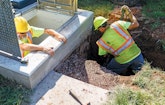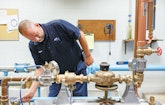Interested in Safety?
Get Safety articles, news and videos right in your inbox! Sign up now.
Safety + Get AlertsWinning awards is one thing. Staying ahead of the curve is another. The North Penn Water Authority in suburban Philadelphia has managed to do both while also dramatically shrinking its staff.
Headquartered north of Philly in Lansdale, Pennsylvania, the North Penn Water Authority is a municipally owned, nonprofit agency founded 53 years ago to improve the reliability of the region’s drinking water supply. Seven communities came together in 1965 to meet the needs of 7,000 water customers. Today, the system has 34,000 customers in 21 municipalities. Along the way, North Penn Water Authority reinvented its water sourcing, dodged a bullet named Hurricane Sandy, and figured out how to do more with less.
“I would say that, back in the 1960s, the Authority could not have anticipated all the growth we’ve experienced,” says Anthony Bellitto Jr., the organization’s executive director since 1998. But successive generations of North Penn Water Authority board members and management have overseen systematic expansion of the system as townships filled up with residential and commercial properties. In 2017, water demands continue to grow, albeit at a slower pace, and North Penn Water Authority officials are confident the mature system’s capacity is more than sufficient to meet current and future needs.
Securing a source
This progress did not occur without struggle. In the beginning, the fledgling organization relied on groundwater to meet customer requirements, developing dozens of wells. It wasn’t enough. Shortages occurred throughout the 1970s and 1980s, including periods when water-use restrictions were imposed. Not until 1989 did the North Penn Water Authority find a permanent solution by tapping lake water and supplementing with water pumped out of the Delaware River, as well as by constructing an interim treatment plant with a capacity of 3.2 mgd.
The era of chronic water shortages ended with the building of a permanent, state-of-the-art treatment facility called Forest Park and a move away from reliance on groundwater. From a high of 73 wells, North Penn Water Authority now operates just 15 production wells and relies on surface water for 90 percent of its supply.
In keeping with the suburban character of the region, 80 percent of the North Penn Water Authority’s customers are residential. But the other 20 percent is split among commercial and industrial customers, including pharmaceutical and meat-packing facilities that use a significant volume of water. To supply it, the Forest Park plant now typically churns out 30 mgd and close to 40 mgd on peak demand days. Confidence is born of such numbers. “We have no more shortages and no more problems in meeting growth in the area,” Bellitto says.
Industry takes notice
The North Penn Water Authority’s success is being recognized. In 2012, the treatment plant — which is owned and operated by North Penn and North Wales water authorities — received the American Water Works Association Presidents Award as part of the Partnership for Safe Water. Two years later, the Pennsylvania Department of Environmental Protection handed the treatment plant the Area-Wide Optimization Program Award for its “outstanding efforts” to remove turbidity from its water. The plant has earned the honor more than once.
This year, the utility received two more significant recognitions. The AWWA’s Distribution System Optimization Program Directors Award of the Partnership for Safe Water was bestowed on North Penn Water Authority for excellence in water distribution “above and beyond” regulated safety standards. The North Penn Water Authority became the first public water utility in Pennsylvania and among the first in North America to meet the rigorous standards for the award, which includes a peer-reviewed comprehensive self-assessment of operations.
Bellitto is a licensed professional engineer. He says the North Penn Water Authority earned the Directors Award before any other system in Pennsylvania because the board and management targeted it. “The award is a recent development in recognizing excellence. The AWWA wisely said, ‘Great — you’ve optimized water at the source. But how about in the distribution system?’”
The award acknowledges “the whole dynamic of moving the water. We wanted to be the first to win the award and help establish a new expectation of what it means to provide safe, quality water.”
The other formal recognition of excellence came to Bellitto himself. He received the AWWA’s Samuel S. Baxter Award for outstanding leadership and service in the cause of safe public drinking water. The award recognizes that Bellitto is ultimately responsible for all of the North Penn Water Authority’s planning, engineering, operational and financial functions. Thus, the North Penn Water Authority’s success was inextricably linked to his performance.
Investing in the future
Water systems are capital-intensive operations. Lots of hardware and infrastructure collect and move the water and need constant replacement or refurbishment. The North Penn Water Authority includes 11 above-ground water storage tanks, 575 miles of water main, nine booster stations, collection pumps that move 10 percent of the supply, and 15 production wells. Though growth of the customer base has slowed to 2 to 3 percent from 8 percent or so in previous years, “bulk sales” are growing at a much higher rate, so the system components continue to be constantly stressed. A bulk sale of water occurs when water is transmitted to a large-volume user outside the 100-square-mile system.
The heart of the North Penn Water Authority system is the Forest Park Water Treatment Plant. The plant was expanded 10 years ago and retrofitted with a membrane filtration system, which is deemed the most advanced process available and is more commonly used in Europe than in the United States. “We needed to upgrade the plant and took note that the EPA was on track for more stringent regulations, so we decided to look for the most advanced filtration technique,” Bellitto says. “It was well worth the investment.”
The system incorporates 45 million hollow-tube filters that remove any impurities larger than 0.1 microns from already clarified water. The method is considered the best option for eliminating microscopic particles. Forest Park water is then treated with ozone gas and receives a couple other treatments before being chlorinated and collected in a 2-million-gallon underground reservoir.
To keep the plant humming and water flowing, North Penn Water Authority spends millions of dollars annually on equipment, operations and maintenance — nearly $7 million in 2016 alone. That level of investment was more than offset in 2016 by operating revenue and nonoperating income totaling nearly $40 million. The number was skewed by a one-time payment of $15 million from a water system 17 miles away that began buying capacity for 10 mgd, an example of a bulk sale. “The one-time payment was for a share of our previous capital investment,” Bellitto says. “They would have had to spend a lot more to build their own treatment plant.”
Other expenses include installation in 2007 of a backup generator for the treatment plant — a critical component after Hurricane Sandy struck — and creation of 15 interconnections to neighboring water systems. These water-exchange points are mutually reassuring because each entity is able to give or receive water as needed in an emergency. The generators and intersystem connections are a corollary to numerous redundancies built into the North Penn Water Authority system. For example, in 2016, the North Penn Water Authority spent $1.5 million for a second transmission main from Forest Park to the system.
“The larger we grow, the more important these redundancies become,” Bellitto says. “The biggest vulnerability we had was having just one mainline running from the treatment plant to the service area. It cost money, but it really works out for us in terms of reliability.”
Less is more
Growth and redundancy do not carry through to staffing. Twenty years ago, 70 full-time staff members were employed by the North Penn Water Authority. Today, Bellitto has a staff of 49 full-time employees, four part-time employees, and a couple of college interns during summer months. Management is a staff of eight, with eight supervisors answering to them and overseeing 22 people in the field. This staff shrinkage has occurred despite the system’s growth in customers, water distribution and miles of main.
“We’ve been very good at streamlining and making ourselves an efficient organization,” Bellitto says. He cites automation of such tasks as meter reading as well as cross-training of employees.
“We are as lean as we can possibly be because we are conscious that we’re a nonprofit agency and need to strive for zero waste and high utilization of staff members. We’re really proud of being able to do that.”
Bellitto credits the 10-member board for working together harmoniously in their oversight and decision-making. “Whenever you get 10 people together representing 10 different communities, it can be a challenge, but our board works together well, and members have developed good relationships. They are appointed by their communities but approach their board work with a collaborative spirit.”
Dealing with customers and the public is the biggest challenge. “The easier part is getting water from point A to point B. We have technical people who can do that in their sleep. I know water is going to get to our customers in a reliable way. The bigger challenge is dealing with misinformation.”
Bellitto and his public relations aides encourage customers to call the office if they have water concerns or questions about their bills.
“We want them to call. We encourage dialogue with our customers.”
Standing up to Sandy
Every water authority experiences a crisis at one time or another. One crisis that threatened the North Penn Water Authority came in October 2012 when Hurricane Sandy swirled along the East Coast with damaging winds and storm surges.
Pennsylvania officials declared a state of emergency, and the mayor of Philadelphia asked residents in low-lying areas to move to safer ground. After the storm wreaked havoc, electricity providers brought in crews from as far away as New Mexico to restore power.
The area in which North Penn Water Authority operates lost electrical power for four days. The good news was that no North Penn Water Authority customers lost service because the North Penn Water Authority had anticipated just such a crisis. In 2007, it had installed a diesel-powered backup generator for its Forest Park Water Treatment Plant. The generator was in addition to two separate electrical feeds to the plant, which were duplicated as a fail-safe measure in case one line failed.
“It was a very good thing that we installed the generator, of course,” Executive Director Anthony Bellitto says. “I cannot imagine how disastrous it would have been had we not had use of that plant for four days.”
The generator installation cost North Penn Water Authority $1.5 million dollars. “We have put a lot of money and time into developing redundant systems. We had redundancy at the plant, and as luck would have it, we needed it when Sandy struck. Instead of responding to unexpected events and emergencies like that storm, redundancies in the system let us anticipate them.”
Some 15 million gallons of water were processed each day for four days using the generator, with employees performing many functions manually after remote control components were rendered inoperative by the storm.
“A water treatment plant is like a hospital,” Bellitto says. “It can never go down.”











